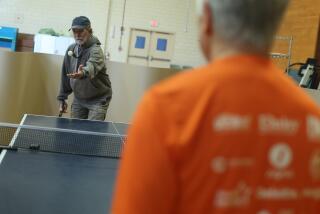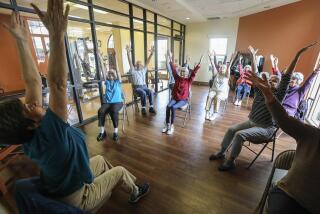Nursing Homes Accent the âHomeâ
You enter the nursing home to the sound of chirping birds. Sunlight streams through large windows and, across a courtyard, pansies and daffodils surround a small greenhouse. A black cat stalks down a corridor, looking as if it owned the place. Your grandmotherâs nursing home was nothing like this.
Like a handful of homes across the country, Levindale Hebrew Geriatric Center in Baltimore uses plants, pets and regular interaction with children to enliven and give meaning to the lives of frail elderly residents. Such innovations are the result of philosophies that share a common goal: to put the âhomeâ into nursing home and scrap the hospital (some say prison) model.
The pioneering homes, which offer services at roughly the same cost as traditional facilities, judge their performance not only on medical outcomes, such as fewer bedsores or falls, but on whether nursing home life is a pleasant, even vibrant, experience. Hallmarks of these facilities include less institutional design, greater resident choice in how they spend their days, nursing assistants empowered to make more decisions and strengthened relationships between residents and staff.
Innovators profess no small ambitions. âOur mission is to advocate and facilitate deep system change and transformation in the culture of aging,â says Rosemarie Fagan, executive director of the Pioneer Network, a coalition of providers, family members and others founded in 1997 to help reinvent nursing homes. âThe nursing home is a microcosm of our society and our values. It really mirrors ... who we are.â
With 1.5 million people living in the nationâs 17,000 nursing homes and an estimated 40% of Americans expected to spend some time there in the future, according to University of North Carolina researcher Philip D. Sloane, the demand for improvement is strong. âWhenever you have a [place] thatâs viewed as so bad people say they would rather be dead than be in one, you have a problem,â Sloane says.
Passage in 1987 of the Nursing Home Reform Act--which includes a 10-point Residentâs Bill of Rights (such as the right to be treated with dignity and to exercise self-determination)--prompted industry changes, such as a reduction in the use of physical restraints. In 1998, the Health Care Financing Administration announced the Nursing Home Initiative, aimed at addressing persistent problems.
Whatâs needed now, say many in the field, is not more regulations but tougher enforcement--and a change of mind-set. In the old medical model, the goal was to keep residents fed, dressed and bathed as efficiently as possible.
âThey might be miserable, embarrassed or cold, they may have the food forced down them, but we would have accomplished our goal,â Sloane says. âBut if your goal is for them to have a good experience, we approach it differently. Maybe we wonât bathe them as often or maybe they wonât have exactly the right diet, but theyâll be happier.â
What may help the program catch on is this: Breaking the industry mold may make good business sense, at least in the long term. For example, at Levindale, the average daily occupancy rate jumped some 10 points to its current 98% after implementation of the Eden Alternative philosophy. The higher rate, says Levindale President Ron Rothstein, has offset renovation and other costs associated with the changeover.
It may sound reasonable, but it hasnât caught on in a big way yet: Fagan estimates that fewer than 1% of nursing homes have embarked on the kind of transformation espoused by the Pioneer Network.
One nursing home implementing such an approach is Providence Mount St. Vincent in Seattle. In 1991, when the home needed remodeling, its leaders decided to turn it into a facility based on âresident-directed care.â The home was reconfigured into âneighborhoodsâ of two dozen residents each, with a new on-site day-care center for children of staff and others in the community.
âResidents are now at the top of the organization chart,â says administrator Charlene Boyd, a Pioneer Network founder. âWe got rid of most of the middle management and decentralized food service, laundry and housekeeping.â Staff members pitch in and help residents with such tasks as getting a cup of coffee, doing a load of laundry or simply playing cards and talking.
âThe entire building feels like a neighborhood in some ways, with pets and little kids coming and going,â says Sandra Twist, whose mother, Meredith Groat, is a resident there. âPeople are in a variety of settings--in their room watching TV or reading or out in the open area near the kitchen, which is nicely lit with round tables. Some [residents] are pulled up to the nursesâ station, chatting. On Momâs unit thereâs a solarium. Itâs got a computer for people to check their e-mail. Another floor has a nicely appointed library, like an old gentlemanâs club. Another has an aviary.â
Being able to decide when to go to bed or what to eat is especially important for people like her mother, she says, whose choices are limited by chronic disease.
Other innovators have seized on the same concept.
âWhy should [nursing home residents] lose their rights?â asks Eric Haider, chief executive of Crestview Nursing Home in Bethany, Mo., who has developed a model he calls the Ideal Nursing Home. âIf they have a physical or mental problem, it doesnât mean they have lost who they were. They are good citizens. They fought in our wars, built our bridges and highways. Now theyâre in the nursing home. Itâs our job to give them the best--not by bossing them around, but by simply asking them what they want and honoring their desires.â
At Crestview, this means giving residents the same choices the rest of us take for granted. Want to go fishing? A pond is nearby. Youâd like to buy a gift for your granddaughter whoâs coming to visit? A staff member will drive you to the mall. Got a hankering for pizza, but itâs not on todayâs menu? âThe typical [nursing home] answer is, âWe donât have pizza,â â Haider says. âThe answer at Crestview is, âWould you like to go to Pizza Hut, or do you want us to go and bring it back?â â
This first-class service is not reserved for an elite group but is offered to every resident, the majority of whom, as in most nursing homes, are low-income people on Medicaid with various levels of dementia. Crestview charges $79 a day--just below the middle range nationally of $80 to $150, depending on region, type of facility and level of care. One area of savings is in medical supplies. Out of 154 residents, only three wear diapers, down from 53 before Haider took over. That change amounts to a $6,500 annual savings. âWe have teams and keep the same staff [assignments],â Haider says. âThey get to know the residents and take them to the bathroom when they need it.â
In El Sobrante, Calif., Barry Barkan, chief executive of the Live Oak Living Center and another Pioneer Network founder, developed a model he calls the âregenerativeâ nursing home. âWhat we have done is to create a culture thatâs based on the simple belief that those in long-term care are the elders of our people,â he says. âTheyâre growing, learning, developing, and they deserve respect and honor. They still have a birthright to joy and pleasure--and they have work to do, which is to formulate a legacy of their past life experiences for future generations.â
The heart of the Live Oak program is a daily community meeting, a combination consciousness-raising session, songfest and news exchange. âItâs emotional, itâs intellectual, itâs spiritual and it builds connections between people,â Barkan says.
One satisfied resident is Verda Mason, 79, who grew up picking cotton in Monroe, La., and has lived at Live Oak for two years. âEveryone is so friendly and kind,â she says in a phone interview. âI canât see and I canât walk, but I do enjoy my place here. At the meetings, Iâm the one who gives the song and the scripture.â
The community-building effort has another benefit. âItâs a very joyful environment, with an enormous amount of emphasis on multicultural harmony,â Barkan says. The result: low staff turnover--less than 20% per year.
Nationally, annual staff turnover among certified nursing assistants--nursesâ aides who are a nursing homeâs front-line caregivers--is more than 100%. Low wages, difficult working conditions, little respect and no chance for advancement give caregivers little reason to invest years in their careers. Unless nursing home managers can staunch the outward flow of their labor force, residents are unlikely to feel part of a stable, caring community.
âWe know through studies that the happier [care providers] are, the better the care is,â says Sheryl Zimmerman, co-director with Sloane of North Carolinaâs Program on Aging, Disability and Long-Term Care. âThe biggest problem has to do with [nursing assistants] not feeling thereâs room for growth or being empowered.â
At Wellspring Innovation Solutions, an association of 11 nonprofit nursing homes in Wisconsin, teams of nurses, aides, housekeeping staff and dietary workers attend off-site training retreats, led by a geriatric nurse practitioner, to learn best clinical practices for behavior management, nutrition and other types of patient care. Managers are taught to be coaches and mentors of staff, rather than authority figures. Improvements in care are measured and posted for everyone to see.
âBefore, they didnât push education for [aides] or housekeeping [staff],â says Mary Jo Westphal, certified nursing assistant/care delivery specialist at Good Shepherd, a Wellspring home. âNurses would talk among themselves about a resident and never share information or clue us in. Now the whole staff learns things.â This open approach has even affected lunch breaks, with staff members mingling with each other far more, says Westphal.
Robyn Stone, director of the Institute for the Future of Aging Services at the American Assn. of Homes and Services for the Aging, a trade group for nonprofit homes, conducted a recent study of the Wellspring approach and found that by many measures Wellspring homes outperformed others. Wellspring not only had better staff retention rates than other homes, its caregivers also used restraints less frequently, identified bedsores earlier and had better procedures to help with incontinence. âWe found that it did not cost Wellspring facilities any moreâ than what it costs traditional facilities to operate, Stone adds.
The movement toward empowering caregivers and residents is likely to get a new push from aging baby boomers anxious to make change for their parents and themselves, say many experts. âTheyâre much stronger advocates,â the Pioneer Networkâs Fagan says. âTheyâre the ones saying, âWhat do you mean Mom canât watch television in the middle of the night--or have a glass of wine with dinner?â â






